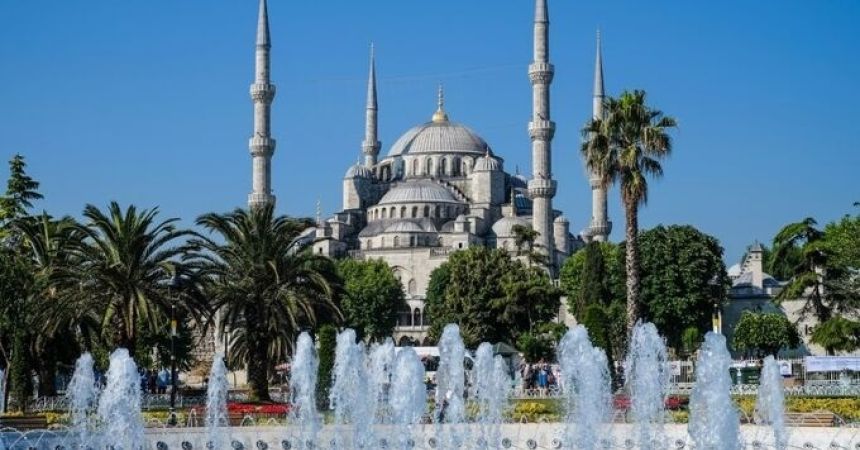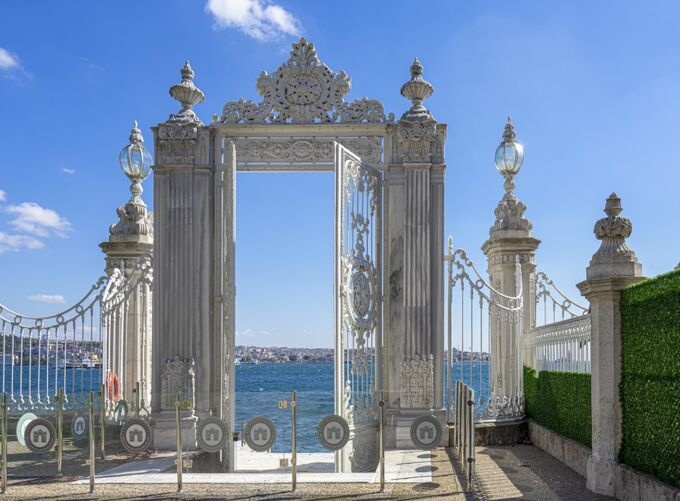
Turkey’s Grand Mosques & Palaces | Best to Visit
Turkey is a treasure trove of historical and architectural wonders, showcasing a rich cultural heritage shaped by various civilizations over millennia. Among the most stunning features of this heritage are its historic mosques and palaces, which not only reflect the architectural brilliance of their times but also tell the stories of the empires that once flourished in this region. This comprehensive guide will take you through some of Turkey’s most iconic mosques and palaces, providing insights into their history, architectural significance, and practical tips for your visit.
The Blue Mosque (Sultan Ahmed Mosque) – Istanbul
The Blue Mosque, officially known as the Sultan Ahmed Mosque, is one of the most iconic landmarks in Istanbul. Built between 1609 and 1616 during the reign of Sultan Ahmed I, this mosque is renowned for its stunning blue tiles, grand domes, and majestic minarets.
Architectural Highlights of Turkey
- Interior Design: The mosque features over 20,000 handmade Iznik tiles in blue, green, and white, giving it its nickname. The intricate calligraphy and beautiful stained glass windows enhance the mosque’s serene ambiance.
- Dome and Minarets: The mosque has a central dome supported by four massive pillars, surrounded by smaller domes. The six minarets are a distinctive feature, symbolizing the mosque’s significance.
Visiting Tips of Istanbul
- Opening Hours: The mosque is open to visitors outside of prayer times. It’s advisable to check the schedule before your visit.
- Dress Code: Modest attire is required; women should wear a headscarf, and men should avoid shorts.
- Timing: Visit early in the morning or late in the afternoon to avoid crowds and enjoy the beautiful light for photography.
Hagia Sophia – Istanbul
Originally built as a cathedral in 537 AD, Hagia Sophia has served various religious purposes throughout its history, including being a mosque and now a museum. It is an architectural marvel and a symbol of Byzantine and Ottoman empires.
Architectural Highlights
- Dome: The massive dome, which appears to float above the central nave, was an engineering feat of its time and continues to inspire architects.
- Mosaics: The interior is adorned with stunning mosaics depicting Christian iconography, which were later modified to include Islamic elements.
Visiting Tips of Hagia Sophia
- Entrance Fee: As of recent changes, Hagia Sophia may charge an entrance fee. Check for the latest information before your visit.
- Audio Guides: Consider renting an audio guide or joining a guided tour to learn more about the fascinating history and architecture.
- Best Time to Visit: Early morning visits can provide a quieter experience and better lighting for photography.
Topkapi Palace – Istanbul
Topkapi Palace was the primary residence of Ottoman sultans for over 400 years, from the 15th to the 19th century. This sprawling complex reflects the grandeur and opulence of the Ottoman Empire.
Architectural Highlights
- Courtyards: The palace features four main courtyards, each with its own distinct character and purpose. The first courtyard is accessible to the public, while the other courtyards were reserved for the sultans and their court.
- Harem: The Harem section of the palace is particularly fascinating, offering insight into the private lives of the sultans and their families. Istanbul Guided tours provide a deeper understanding of this intriguing area.
Visiting Tips of Topkapi Palace
- Tickets: Purchase tickets in advance to avoid long queues. Consider getting a combined ticket for access to the Harem section.
- Guided Tours: A guided tour can enhance your experience, providing historical context and insights into the palace’s architecture and artifacts.
- Photography: Photography is allowed in most areas, but be respectful of the ambiance and other visitors.
Suleymaniye Mosque – Istanbul
Overview
The Süleymaniye Mosque, designed by the renowned Ottoman architect Mimar Sinan, is one of the largest and most impressive mosques in Istanbul. Built between 1550 and 1557, it serves as a testament to the architectural achievements of the Ottoman Empire.
Architectural Highlights
- Symmetry and Proportions: The mosque’s design emphasizes symmetry and proportion, creating a harmonious and majestic appearance.
- Courtyard: The large courtyard features an elegant fountain and is surrounded by beautiful arches, providing a tranquil space for reflection.
Visiting Tips Suleymaniye Mosque
- Prayer Times: As a functioning mosque, be mindful of prayer times when planning your visit.
- Access: The mosque is free to enter, making it an accessible destination for travelers.
- Cultural Respect: Be respectful of worshippers and the sacred atmosphere, and ensure you dress modestly.
Dolmabahce Palace – Istanbul
Dolmabahçe Palace, located on the shores of the Bosphorus, was built in the 19th century as a symbol of the Ottoman Empire’s modernization. The palace combines various architectural styles, including Baroque, Neoclassical, and Ottoman.
Architectural Highlights
- Grand Staircase: The palace features a magnificent grand staircase made of marble, leading to the main entrance.
- Crystal Chandelier: The palace is home to one of the world’s largest Bohemian crystal chandeliers, which weighs 4.5 tons and adds to the opulence of the interior.

Visiting Tips of Dolmabahce Palace
- Tickets: Purchase tickets in advance, as guided tours are recommended to explore the palace’s rich history and stunning architecture.
- Guided Tours: Consider joining a guided tour for insights into the palace’s history and significance in the Ottoman Empire.
- Best Time to Visit: Morning visits are ideal to avoid crowds and enjoy a leisurely exploration.
The Great Mosque of Diyarbakır (Ulu Camii) – Diyarbakir
The Great Mosque of Diyarbakır, known as Ulu Camii, is one of the oldest and largest mosques in Turkey, dating back to the 11th century. It serves as a prime example of Seljuk architecture and is a significant religious site in the region.
Architectural Highlights
- Stone Structure: The mosque is constructed of dark basalt stone, giving it a distinctive appearance. Its interior features a large prayer hall with numerous columns.
- Mihrab: The beautifully decorated mihrab (prayer niche) is a focal point within the mosque, showcasing intricate stone carvings.
Visiting Tips Diyarbakır
- Opening Hours: The mosque is open to visitors outside of prayer times. Be mindful of local customs and the worship schedule.
- Cultural Etiquette: Dress modestly and be respectful of the sacred atmosphere while visiting.
Rustem Pasha Mosque – Istanbul
The Rustem Pasha Mosque, located in the Eminönü district of Istanbul, is a hidden gem known for its stunning İznik tiles and beautiful architecture. Built in the 16th century for Grand Vizier Rüstem Pasha, it is often overshadowed by larger mosques but is equally impressive.
Architectural Highlights
- Iznik Tiles: The interior is adorned with exquisite İznik tiles in intricate floral patterns, making it one of the most beautifully decorated mosques in Istanbul.
- Location: The mosque’s location offers breathtaking views of the Golden Horn, providing a unique backdrop for your visit.
Visiting Tips
- Off the Beaten Path: This mosque is less crowded than other major attractions, making it a peaceful place to visit.
- Photography: Capture the stunning tile work and architecture, but be respectful of worshippers.
Topkapi Palace – The Harem and Treasury
Topkapi Palace is not just a magnificent architectural complex but also a treasure trove of artifacts from the Ottoman Empire. The Harem and Treasury sections are particularly fascinating, offering insights into the opulence of the sultans.
Harem Highlights
- Intricate Rooms: The Harem consists of beautifully decorated rooms, each with its own unique style and purpose. The Valide Sultan’s room is especially noteworthy for its stunning architecture.
- Cultural Insights: Explore the stories of the women who lived in the Harem and their influence on the Ottoman court.
Treasury Highlights
- Precious Artifacts: The Treasury houses an impressive collection of jewels, including the famous Topkapi Dagger and the Spoonmaker’s Diamond, one of the largest diamonds in the world.
- Historical Significance: Each piece in the Treasury tells a story of the grandeur and wealth of the Ottoman Empire.
Visiting Tips
- Guided Tours: Consider joining a guided tour to learn more about the history and significance of the Harem and Treasury.
- Advance Tickets: Purchase tickets in advance, especially for the Harem, as entry is limited.
Kariye Museum (Chora Church) – Istanbul
Originally a Byzantine church, Kariye Museum, also known as Chora Church, is famous for its stunning mosaics and frescoes depicting scenes from the life of Christ. The church has a rich history, having served as a mosque before becoming a museum.
Architectural Highlights
- Mosaics: The mosaics in the church are among the finest examples of Byzantine art, showcasing intricate details and vibrant colors.
- Frescoes: The frescoes on the church’s walls provide a fascinating glimpse into religious iconography and artistry during the Byzantine era.
Visiting Tips
- Entrance Fee: There is an entrance fee to visit Kariye Museum, so check for the latest information before your visit.
- Guided Tours: Consider joining a guided tour to gain a deeper understanding of the art and history of the church.
The Green Mosque (Yesil Mosque) – Bursa
The Green Mosque Bursa, or Yesil Mosque, is one of the most important examples of early Ottoman architecture, located in Bursa, the first capital of the Ottoman Empire. Built in the 15th century, it is known for its beautiful tile work and stunning architecture.
Architectural Highlights
- Green Tiles: The mosque’s interior features exquisite green tiles, giving it its name. The tiles showcase intricate geometric patterns and floral designs.
- Calligraphy: The mosque is adorned with beautiful calligraphy, adding to its artistic significance.
Visiting Tips
- Dress Code: As with all mosques, modest attire is required. Women should cover their heads, and men should avoid shorts.
- Prayer Times: Be mindful of prayer times when planning your visit, as the mosque is still active.
Guide to Turkey’s Historic Mosques and Palaces
Turkey is a land of rich history and breathtaking architecture, with its historic mosques and palaces standing as testaments to the ingenuity and artistry of past civilizations. From the iconic Blue Mosque in Istanbul to the serene beauty of Kariye Museum, each site offers a unique glimpse into the cultural heritage of Turkey.
Visiting these historic landmarks provides an opportunity to immerse yourself in the fascinating stories of the past while appreciating the intricate artistry and architecture that define Turkey’s identity. As you explore these magnificent mosques and palaces, you’ll gain a deeper understanding of the country’s rich cultural tapestry and the diverse influences that have shaped it over the centuries.
So, whether you’re wandering through the ornate halls of Topkapi Palace, admiring the mosaics of Kariye Museum, or soaking in the spiritual ambiance of the Blue Mosque, Turkey’s historic mosques and palaces promise an unforgettable experience that resonates with the echoes of history. Plan your visit to Turkey, embrace the cultural richness, and let the wonders of Turkey’s architectural heritage captivate you.



